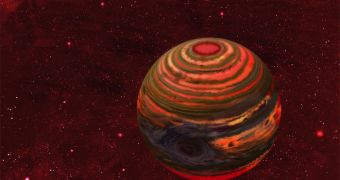A team of astronomers studying a brown dwarf star relatively far away from Earth announced at a conference yesterday that the object is most likely being shaken up by tremendous storms on its surface. The new study reveals more data on the elusive nature of such objects.
Brown dwarfs cannot be analyzed in great detail because they are very cool. They are so-called failed stars, celestial objects that collapsed from molecular hydrogen clouds like normal, Sun-sized stars did, but failed to ignite properly.
As such, they are doomed to haunt the boundaries between fully-fledged stars and massive gas giants. Because of their low surface temperature, they can only be detected by highly-advanced space telescopes observing the Universe in infrared wavelengths.
Such is the case with 2MASS J21392676+0220226, the brown dwarf researchers focused on in the new study. During a short period of time – spanning only 8 hours – the distant object displayed brightness variations of up to 30 percent.
“We found that our target's brightness changed by a whopping 30 percent in just under eight hours. The best explanation is that brighter and darker patches of its atmosphere are coming into our view as the brown dwarf spins on its axis,” University of Toronto graduate student Jacqueline Radigan said.
The expert will be the host of a presentation on the issue, which she will hold at the Extreme Solar Systems II conference, currently being held in Jackson Hole, Wyoming. Astronomers tend to agree that weather patterns on brown dwarfs are very similar to those on gas giants.
By analyzing the characteristics of climates such as this one, experts could gain more insight into the nature of climate on extrasolar planets, including hot Jupiters, super-Earths and regular gas giants.
“We might be looking at a gigantic storm raging on this brown dwarf, perhaps a grander version of the Great Red Spot on Jupiter in our own solar system, or we may be seeing the hotter, deeper layers of its atmosphere through big holes in the cloud deck,” Ray Jayawardhana adds.
The University of Toronto astrophysicist is the author of the recent book called “Strange New Worlds: The Search for Alien Planets and Life beyond Our Solar System,” Space reports. Details of the new study have been submitted for publication in an upcoming issue of the Astrophysical Journal.
The research was conducted using the 2.5-meter telescope at Las Campanas Observatory, in Chile, and spanned several months. As the weeks passed, the same amount of variation was steadily recorded.
“Measuring how quickly cloud features change in brown dwarf atmospheres may allow us to infer atmospheric wind speeds eventually and teach us about how winds are generated in brown dwarf and planetary atmospheres,” Radigan concluded.

 14 DAY TRIAL //
14 DAY TRIAL //